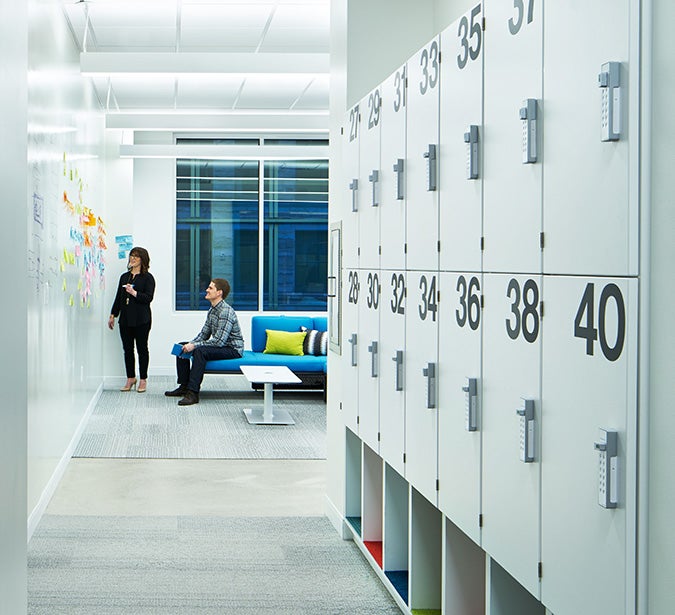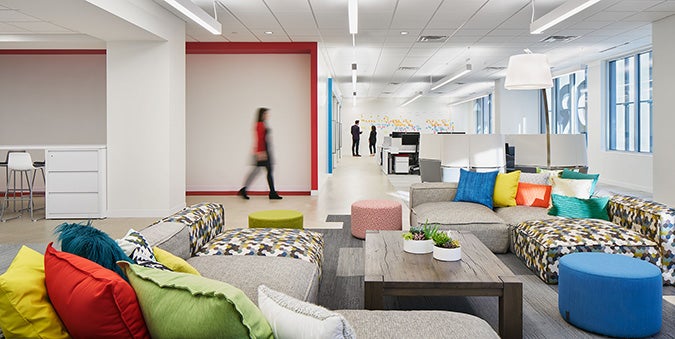
Leading the Way to Workplace Wellness Through Office- and Site-Design Research
Reimagining Workspaces for a Healthier Tomorrow
Today’s headlines are flooded with news about the COVID-19 pandemic and global efforts to stem the tide of infection. Hospitals and medical facilities are inundated with new cases and struggling to acquire much-needed ventilators and protective equipment for staff on the front lines. Meanwhile, non-essential businesses and public spaces are closing and many who are still employed are working from home and practicing social distancing. It’s no overstatement to suggest there is no greater concern right now than people’s health and well-being.
Even before the outbreak, however, the global wellness trend grew exponentially across various industries in recent years as companies sought to invest in their most important asset: people. In fact, wellness is among the largest and fastest-growing industries, outpacing global economic growth by almost double (6.4% vs. 3.6%, respectively, between 2015 and 2017).1 And the need for improved public health is urgent. Nearly half of U.S. adults suffer from one or more chronic health conditions that have the potential to be prevented through changes in behaviour and environment.2
As such, corporate health and wellness programs have become increasingly popular among U.S.-based companies. Almost half of U.S. employers say health and productivity programs are essential to their company strategy, while 91 percent report offering wellness programs beyond medical cost savings, according to the International WELL Building Institute (IWBI).3
The IWBI also reports that the physical workplace is one of the top three factors affecting job performance and satisfaction, citing a study in which 90% of employees surveyed reported that their attitude about work is adversely affected by the quality of their work environment. Further, the Center for Active Design notes that 49% of building owners are willing to pay more for facilities demonstrated to have a positive impact on health.4
The wellness trend is far more than a feel-good approach to creating workplaces, however. Business leaders who ignore the impact of workplace environments on human health do so at their own peril and that of their employees. Workforce “unwellness” (chronic disease, work-related injuries and illnesses, work-related stress, and employee disengagement) may cost the global economy 10% to 15% of economic output each year.5 Additionally, an estimated 12.7% of deaths could be averted by improving air quality worldwide.6 The World Health Organization suggests lowering levels of air pollution will reduce the burden of respiratory and cardiovascular disease-related illnesses, healthcare costs, and lost worker productivity due to illness, as well as increase life expectancy among local populations.
The building industry is well-attuned to the growing need for healthy design, as evidenced by approximately 4,000 WELL-certified projects and 650 Fitwel-certified projects around the world. The cohort of building professionals with the knowledge and expertise to design for health will continue to grow rapidly over the next decade, according to the IWBI. Clearly, the wellness movement is here to stay and, as such, it’s vital for leaders of organizations of all sizes to understand how their buildings affect occupant health, now more than ever.

Connecting the Dots with Data
Wellness is a goal we must consider in workplace design, but many have taken broad strokes in applying it, with mixed and often unknown or unreported results. Building certification systems such as Fitwel and WELL offer valuable frameworks for designing buildings with human outcomes in mind, and we at HDR routinely factor these recommendations into our designs. We also know that no one can predict or improve outcomes if they don’t actually measure.
Therefore, as a matter of practice, HDR gathers data from multiple sources, including the people who use the spaces and places we design. We analyze that data, which can be both quantitative and qualitative, to determine specific needs, including those that might be relatively unique to a given organization or setting, and steer the direction for design objectives and strategies. In other words, research uses “big” and “small” data to connect the dots between the work we do and the outcomes that matter for people and their organizations and communities.
For example, there is general acknowledgement that attributes of the built environment either promote or discourage physical activity, a modifiable health behaviour that is a strong predictor of multiple health outcomes, including mortality. However, existing research examining the relationships between workplace environment and physical activity leaves many questions unanswered. A recent systematic review of studies in offices designed for “activity-based working” found limited evidence of effects on health-related outcomes and physical activity.7 With the quality and consistency of current evidence in mind, HDR is building upon past studies by examining not only workplace interior features, but by holistically examining the worksite, including the building, its location, and neighbourhood attributes.
Because HDR is committed to supporting the well-being of our employees, we identified a need to understand the actual impacts of our own new and upgraded workplace designs being rolled out across many of our offices over the past few years. To that end, we are conducting an internal, 19-city study of our offices that addresses questions about the impacts of the work environment on employee outcomes such as collaboration effectiveness, ability to perform high-quality work, satisfaction with the office environment, and well-being in the workplace, as well as objectively measured work-time physical activity and sedentary behavior.

Walking the Talk
Phase 1 of our internal study represents a first step in a three-year process of consistent evaluation of our office facilities. Each HDR office has a somewhat unique design and set of characteristics that contribute to both positive experiences and challenges for the employees that work there, which are being documented by a scorecard of individual office characteristics and compared across locations.
The initial study phase evaluates office-design associations with employee outcomes based on primary data collected via an online survey with several validated scale measures and secondary internal data. More than 1,800 employees from 25 offices in 19 cities were assessed to document baseline measures for comparison to future follow-up measures. Most of these offices had yet to move, while a few had relocated prior to the inception of the study and thereby served as a “post” control group for the longitudinal portion of the study.
In the initial cross-sectional analysis comparing groups of existing and new offices, there were several measures for which the new offices scored significantly higher on average. Respondents in the new spaces tended to be more satisfied with access to natural light, ergonomics of workstations, meeting spaces (especially open meeting spaces), thermal comfort and air quality, office location, access to public transportation and had higher overall satisfaction with the office environment. Old offices scored higher, on average, in the convenience and availability of parking, which tended to have an inverse relationship with access to public transportation.
There were no significant differences in more distal work outcomes between the old and new offices, including collaboration effectiveness, although it will be of interest to evaluate any changes in such outcomes in subsequent phases of the study with more sensitive within-subject longitudinal analyses and more in-depth spatial analyses.
In terms of design elements that promote wellness, such as thermal, visual, acoustic and physical comfort, the results varied across location and age of the facilities as one might expect. Thermal comfort scores were mostly in the low-positive range and differed significantly by office and pre/post status, with higher scores for new offices on average. Nearly all respondents in the new offices (93%) agreed that they have access to natural daylight in their work area, compared to 69% of those in the old offices. Not surprisingly, this question also differed by workspace type, with those in open work areas without high panels most likely to agree they have access to natural light. From an acoustical perspective, the study found some indication of a positive relationship between communication privacy and proximity to co-workers, such that scores were higher when respondents' workspaces were closer to those with whom they work most closely.
Offices slated for renovations or moves are being evaluated prior to and several months after the facility change using the same procedures, with results compared to the prior set of results. Specifically, subsequent data-collection phases include surveys of additional offices prior to their moves, baseline objective measures of work-time physical activity and sedentary behaviour in a subset of locations using accelerometers, and, finally, post-move follow-up survey-based and accelerometer measures.
By taking a data-driven and human-centred approach, and a natural-experiment research design, to our own office environments, HDR expects to acquire a more robust understanding of the relationship between buildings and human health and apply the knowledge gained to improve design outcomes both for our own employees and for our clients.
- Wellness Industry Statistics & Facts, Global Wellness Institute
- Multiple Chronic Conditions Among US Adults: A 2012 Update, Preventing Chronic Disease
- The New Role of the 21st-Century Architect and Designer: Health Professional, International WELL Building Institute
- Why use Fitwel? Center for Active Design
- The Future of Wellness at Work, Global Wellness Institute
- Ambient and Household Air Pollution and Health (pdf), World Health Organization
- Is Activity-Based Working Impacting Health, Work Performance and Perceptions? A Systematic Review, Building Research & Information
About the Author
Dr. Jeri Brittin is a public health research scientist who plans and conducts research across facility types, including schools, workplaces, health and behavioral facilities and communities. As the director of research, she leads the research team to uncover design outcomes to inform future facilities.
This article was originally published by CoreNet Global and is used here with permission.



